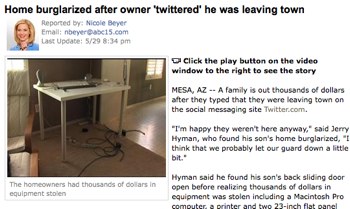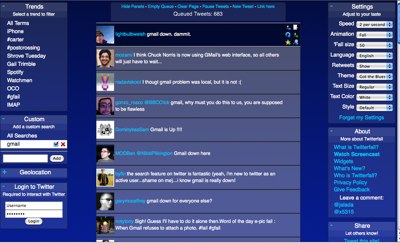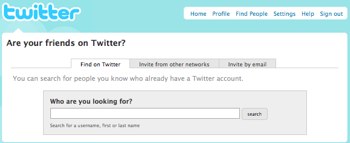 Recently in a bit of frustration, I decided to shift from using an Adobe AIR-based Twitter client on my Mac over to using Nambu, a native Mac OSX app. My frustration is due to the fact that all of the major AIR clients – Seesmic Desktop, TweetDeck and Twhirl – seem to suffer from the problem of consuming a serious amount of CPU usage on my MacBook Pro. I don’t know if this is an inherent issue of using the AIR abstraction layer, which is another layer sitting on top of the operating system, or if the problem lies more in the programming of the applications themselves.
Recently in a bit of frustration, I decided to shift from using an Adobe AIR-based Twitter client on my Mac over to using Nambu, a native Mac OSX app. My frustration is due to the fact that all of the major AIR clients – Seesmic Desktop, TweetDeck and Twhirl – seem to suffer from the problem of consuming a serious amount of CPU usage on my MacBook Pro. I don’t know if this is an inherent issue of using the AIR abstraction layer, which is another layer sitting on top of the operating system, or if the problem lies more in the programming of the applications themselves.
Whatever the case, in frustration this week when my CPU was yet again high and the Activity Monitor showed that the second highest app was one of the Twitter clients, I went off and installed Nambu to give it a try. (The application which is inevitably sucking up the most CPU on my Mac is Firefox… which is why I’m dearly waiting for the real build of Chrome so that I can find and kill off tabs of poorly-written web pages!)
So far, I’ve been very pleased with how Nambu works. Most importantly for me, I can use multiple Twitter accounts. (I tweet from both @danyork and @voxeo and occasionally a couple of others.) All in all the experience is very similar to that of Seesmic Desktop or TweetDeck. There are, though, some differences which I thought I would note here while I think of them:
- “Compose” field is at the bottom of the screen, versus the top as in TweetDeck and Seesmic Desktop. (Not bad, just different and takes some getting used to.)
- “Compose” field doesn’t stay open after you tweet. So if you flip to the Nambu window you can’t just click in and start typing. You have to either click the “Compose” button at the top or press Cmd+N to start a tweet.
- Both TweetDeck and Seesmic (and other Twitter clients) have this UI component where you can go over the picture of someone and have actions right there to either reply, retweet, direct message, etc. In Nambu you have to either click the gear icon on the opposite end of the tweet and then go down to a menu choice… or click on the tweet and click on one of the buttons on the menu at the top. (For me, one value in a desktop Twitter client is speed and the ability to just quickly scan through and act on various tweets. Single-click action buttons are nice for this.)
- Inability to resize the columns. Ideally I’d like to see more columns on the single page (so that I can visually monitor a bunch of searches at the same time). I’d like to make the columns smaller if I want. (Note that I can’t really resize the columns on Seesmic or TweetDeck, either.)
- “Sent” column doesn’t differentiate between tweets/replies and direct messages. All are just shown as “sent”. It would be nice if there was a visual clue as to which ones are direct messages.
- When you click on someone’s twitter name, such as “@danyork”, you get a list of their recent tweets – but I couldn’t see any way to reply to a tweet from that window. I had to click a button to go to their Twitter page to do that.
- That I could see, there was no “in reply to” feature that would show that a tweet from someone was in reply to another tweet. Now… Nambu does have a VERY cool feature that replies to a tweet are threaded underneath the main tweet… if you can find that original tweet. If you can’t find that tweet, though, you are left not easily knowing what the original tweet was.
Again, overall I’ve been quite pleased with Nambu in the few days that I’ve started using it… I’ll write more here as I use it more.
Comments are, of course, welcome.
If you found this post interesting or useful, please consider either subscribing to the RSS feed or following me on Twitter or identi.ca.




 One of the challenges of using Twitter has been that it’s been very hard to find someone’s Twitter account if you know they use Twitter but don’t know what name they use. With no “people search” function on Twitter, you had to try to guess their Twitter account name – or just try to find it through something like Google.
One of the challenges of using Twitter has been that it’s been very hard to find someone’s Twitter account if you know they use Twitter but don’t know what name they use. With no “people search” function on Twitter, you had to try to guess their Twitter account name – or just try to find it through something like Google.
 In a couple of other searches that yielded a number of results, the ranking wasn’t always exactly in the right order, as shown in the image to the right. One wonders if the Twitter folks are sorting into “buckets” of accounts that have similar numbers of followers and then giving those results back.
In a couple of other searches that yielded a number of results, the ranking wasn’t always exactly in the right order, as shown in the image to the right. One wonders if the Twitter folks are sorting into “buckets” of accounts that have similar numbers of followers and then giving those results back.